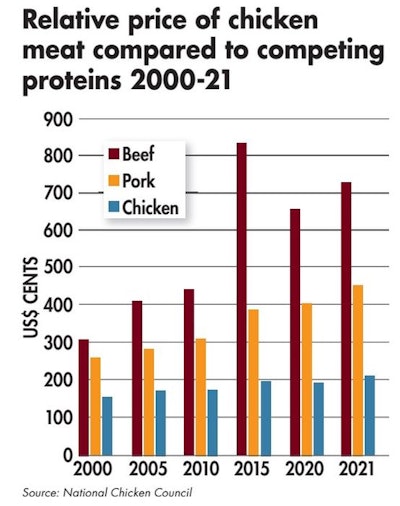
The impact of inflation is hitting the planet hard, and spiking energy and feed costs are putting the poultry industry under strong economic pressure. The good news, however, is that healthy, affordable and nourishing chicken meat continues to gain in popularity.
The challenge is how we, as an industry, manage to meet this growing need, while keeping our products affordable for consumers around the globe. The solution lies in poultry breeding advances in broiler feed efficiency, performance and welfare.
Chicken – the popular protein
Chicken has replaced beef and pork as the world’s most-consumed protein. The Rabobank Global Animal Protein Outlook for 2023 projects that, while consumption growth of other meats is on the decline, poultry is holding steady and, in some markets, will expand.
The value proposition of chicken
Affordability is important, especially during times of high inflation and in feeding people in developing countries.
One reason for chicken’s affordability is production efficiency. Chicken is the most sustainable of all land-based animal proteins, demanding fewer natural resources, like agricultural land and water, or other resources, such as electricity and gas.
And there’s another reason. In the industry, we talk a lot about feed conversion ratio (FCR), or the rate that feed is converted to live body weight. FCR is calculated by taking the amount of feed consumed by the flock and dividing it by the amount of weight gained. Feed typically represents 60-70% of the total cost of poultry production.
Let’s look at the modern broiler compared to 20 years ago. To grow to 2.5 kg (~5.5 lb), a broiler now requires 0.8 kg (1.8 lb) less feed. For farmers that produce 1 million broilers per year, this would represent a savings of 80 metric tonnes (176,370 lbs), which translates to a massive monetary savings.
In addition, better growth rates, along with reduced feed production and transportation requirements, translate to 16% less energy use. When feed and energy costs are lower, chicken prices are more affordable for grocery stores, restaurants and other businesses, which keeps their prices low for consumers.
Welfare and sustainability
Feed efficiency is only part of the story, however. The other is animal welfare.
Healthy birds with good welfare are more resistant to disease, are more robust, have strong livability and perform better for farmers. Better performance means birds excel in production qualities, such as meat yield and daily weight gain. They also thrive in a variety of the world’s climates and growing conditions. This all translates to greater income for producers and, in turn, lower prices for consumers.
Committed to feed the world
Economists predict inflation will remain elevated through 2023, and the current economic stressors may be here a little longer.
The poultry breeding industry is prepared and committed to make chicken more economically sustainable for producers and, in turn, more affordable for the communities they serve. They will do so through steady progress in FCR, growth and bird welfare.
The advances we have seen in bird efficiency, performance, health and welfare will be ongoing. As a result, we are well positioned to overcome the current, and any future, economic challenges, while feeding 9.5 billion people by 2050 with a popular, sustainable, nutritious and affordable protein.

















